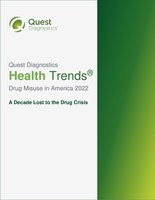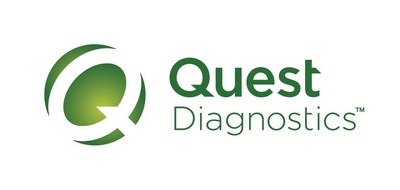PR Newswire
Analysis of 20 million clinical drug tests performed by Quest Diagnostics over the past decade shows increases in drug mixing and amphetamines use, and highlights the need for drug misuse prevention at the earliest stages of risk
SECAUCUS, N.J.
,
Dec. 12, 2022
/PRNewswire/ — Today, Quest Diagnostics (NYSE: DGX) released its latest Health Trends
®
report, “Drug Misuse in America 2022: A Decade Lost to the Drug Crisis.” The report, which harnesses insights from more than 20 million clinical drug tests over 10 years, shows that while progress has been made in the last decade of drug misuse, patients of all ages and both sexes are still at risk.
To access the Health Trends report, visit
Quest Diagnostics Newsroom – Health Trends
®
.
The findings reveal that while illicit fentanyl now causes most of overdose deaths, prescription drug misuse involving opioids and other controlled medications taken by patients under the care of a physician continues at a troubling rate. In 2021, nearly half (49%) of people tested showed evidence of prescription drug misuse, compared to 60% in 2012.
Additional key findings over the past 10 years include:
-
Polysubstance use, or drug mixing, has increased.
In 2021, 52% of drug tests showed evidence of drug mixing, a relative increase of 58% from 33% in 2012. -
Use of amphetamines has surged 5-fold.
In 2021, 9.2% of patients tested were positive for amphetamines, compared to 1.8% in 2012. -
Though individuals of all ages misused medications and illicit drugs at high rates,
younger individuals (ages 18-34 years) were more likely to show signs of misuse
. -
Of those tested, female patients were more likely to use pain-and-anxiety reducing prescription medications, such as opioids and benzodiazepines, while
male patients had higher rates of illicit drugs
, such as cocaine.
“This year’s Quest Diagnostics Health Trends
®
Report underscores the deeply entrenched pattern of prescription drug misuse,” said report co-author
Harvey W. Kaufman
, M.D., Senior Medical Director and Head of the Health Trends Research Program for Quest Diagnostics. “While today’s policy debates about the drug crisis focus largely on reducing illicit fentanyl use, our nationally representative laboratory data is a stark reminder that even patients under a physician’s care can be at significant risk of drug-related harms.”
“As a pain specialist, it is beyond frustrating to see similar patterns of dangerous drug mixing and outright misuse today as those observed 10 years ago,” said board-certified pain expert and report co-author
Jeffrey Gudin
, M.D., Senior Medical Advisor, Drug Monitoring, Quest Diagnostics. “As providers and policy makers reflect on the CDC’s new opioid prescribing guidelines, our laboratory data demonstrates that the medical community must do more to create a truly preventive care model for identifying early signs of prescription drug misuse, similar to screening programs for cancer, heart disease and diabetes.”
The U.S. Centers for Disease Control and Prevention (CDC) recently updated its opioid prescribing
guidelines
to improve the safety and effectiveness of pain care, including with prescription opioids. Among other recommendations, the guidance states that clinicians should consider clinical drug testing (toxicology testing) before staring opioids and periodically (at least annually) during opioid therapy when there is risk of overdose due to mixing with other controlled substances. The CDC also recommends that “clinicians, practices, and health systems should aim to minimize bias in testing and should not apply this recommendation differentially on the basis of assumptions about patients.”
“While our laboratory data does not provide insights based on racial or ethnic characteristics, it does clearly demonstrate that high rates of drug misuse are found in patients of all ages, both sexes and varying kinds of commercial and public health plan coverage,” Dr. Gudin said. “Put simply, patients from all walks of life are at risk of misuse. These findings bolster the CDC’s recommendation that providers aim to reduce bias, such as by applying uniform standards in drug testing.”
In recent years, the prescription opioid crisis has morphed into an illicit fentanyl crisis, with fentanyl, a highly potent opioid, responsible for more than 70% of all overdose deaths today. Prescription opioids are still widely misused: as many as 13,500 overdose deaths were due to prescription opioids in 2021, versus approximately 16,000 in 2012. Polysubstance misuse, such as mixing one or more prescribed controlled medications, is highly prevalent, while deaths from stimulants such as amphetamines have climbed.
An estimated 108,000 deaths were due to drug overdose in the 12-months ending
June 2022
.
For more information on clinical drug testing and different types of tests, please visit
Clinical.QuestDiagnostics.com/WhyClinicalDrugTesting
.
Quest Diagnostics Health Trends studies are performed on aggregate deidentified laboratory data in compliance with applicable privacy regulations and the company’s strict privacy policies, and follow procedures approved by the WCG Institutional Review Board. The present study’s strengths include its large data set, geographic scope, multiple years of test results and validated testing by the highly reliable mass spectrometry method. Its limitations include geographic disparities and inability to validate or contextualize test results with medical records. For the full study methodology, including strengths and weaknesses, please refer to the full report.
About Quest Diagnostics Health Trends®
Quest Diagnostics Health Trends®
is a series of scientific reports that provide insights into health issues, based on patient laboratory data, to empower better patient care, population health management and public health policy. The reports are based on the Quest Diagnostics database of 60 billion deidentified HIPAA-compliant laboratory test results, believed to be the largest of its kind in healthcare. Health Trends research has yielded novel insights into allergies and asthma, cancer, COVID-19, diabetes, heart disease, hepatitis, influenza, Lyme disease, prescription drug misuse and workplace wellness. Quest Diagnostics also produces the Drug Testing Index (DTI)™, a series of reports on national workplace drug positivity trends based on the company’s employer workplace drug testing data.
About Quest Diagnostics
Quest Diagnostics empowers people to take action to improve health outcomes. Derived from the world’s largest database of clinical lab results, our diagnostic insights reveal new avenues to identify and treat disease, inspire healthy behaviors and improve healthcare management. Quest annually serves one in three adult Americans and half the physicians and hospitals in the United States, and our nearly 50,000 employees understand that, in the right hands and with the right context, our diagnostic insights can inspire actions that transform lives.
www.QuestDiagnostics.com
![]()
View original content to download multimedia:
https://www.prnewswire.com/news-releases/one-in-two-patients-tested-misuse-prescription-drugs-finds-10th-annual-quest-diagnostics-health-trends-report-301699514.html
SOURCE Quest Diagnostics

Featured image: Megapixl © Scyther5

















